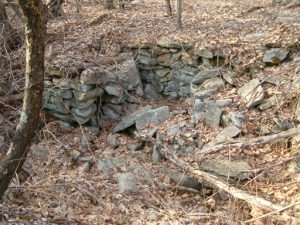In a small section of the town of Smithfield, Rhode Island, all that remains of a once thriving village are a few stone foundations and three legible gravestones. For nearly two centuries, many have speculated about the fate of the residents of Hanton City, an abandoned village named after the Hanton family who once resided there.[1] The settlement is a considerable distance from all the other settlements in Smithfield which were occupied at the time of its existence, leading many to wonder about its purpose, as well as the reason it was eventually abandoned.[2]
The three legible gravestones in the cemetery within Hanton City’s former boundaries belong to members of the Alfred Smith family. Alfred Smith was born on 27 February 1770 and died on 15 October 1828. He was the son of Daniel Smith (born 1 March 1723 and died in Smithfield 25 February 1797) and Else Mowry (born 5 November 1738 and died 18 November 1795). Another gravestone is for Eliza, the wife of Alfred, who was born 17 September 1785 and died 25 February 1840. Lastly, there is a gravestone for Emor, their son, who died 11 February 1826.[3] Unfortunately, these names do not provide any context for the existence of Hanton City, as the Smith family seems to have lived a relatively quiet life, not appearing in any notorious scandals or being known for any illicit activities.
The lack of information on the only known names from the area did not curb speculation surrounding the now-abandoned village. Several theories have been put forth over the years, including the one that the residents were a band of runaway slaves or Native Americans; that they were residents of the town's ‘poor farm’; or that they were loyalists during the American Revolution.[4] The latter theory is rooted in the fact that Samuel Vernon (a Tory from the town of Newport) and many other like-minded individuals were banished to Smithfield and Glocester.[5] These theories all have inherent flaws, however, and as such, cannot be substantiated.
[The] Smith family seems to have lived a relatively quiet life, not appearing in any notorious scandals or being known for any illicit activities.
The most likely scenario regarding the village’s origins and ultimate fate was presented by a resident of the area who was born in Hanton City c. 1809, Thomas Hanton. In 1889, the Providence Journal published a piece titled “A Buried City,” which contained excerpts of an interview with Thomas. In the article, it is stated that the settlement was developed in the 1730s and was home mainly to tanners and boot makers whose primary income was derived from the sale of goods in the markets of Providence.
By the beginning of the nineteenth century, Rhode Island became a national leader in the development and application of mill technology, reducing the need for individual craftsmen, and thus crippling the economic situation among residents of Hanton City.[6] As for the fate of the village’s residents, according to Thomas Hanton “they had all got poor, sold out to anybody, and died off.”[7] Unlike some of the more sensational theories about disease or political dissidence, the information provided by Thomas Hanton offers a plausible explanation for why the town came to be abandoned by the middle of the nineteenth century.[8]
[Conjecture] over the history of Hanton City has continued well into the twenty-first century.
Much like the village itself, the story from the Providence Journal seems to have been lost over time, and conjecture over the history of Hanton City has continued well into the twenty-first century.
Notes
[1] Jim Ignasher, Remembering Smithfield: Sketches of Apple Valley (Mt. Pleasant, S.C.: Arcadia Publishing, 2009).
[2] Ibid.
[3] Smith Family Graves in Smithfield, RI, USGenWeb, http://www.rootsweb.ancestry.com/~rigenweb/stones/smith_graves.html, and Robert and Catherine Barnes, Genealogies of Rhode Island Families from Rhode Island Periodicals (Baltimore: Genealogical Publishing Co., 1983), 2: 57–60.
[4] Ignasher, Remembering Smithfield.
[5] The Diary of Thomas Vernon [microform]: a Loyalist, Banished from Newport by the Rhode Island General Assembly in 1776: With Notes by Sidney S. Rider (Providence: S.S. Rider, 1881).
[6] William G. McLoughlin, Rhode Island, A History (New York: W.W. Norton, 1986), 120.
[7] Ignasher, Remembering Smithfield.
[8] Ken Brown Sr., Smithfield (Mt. Pleasant, S.C.: Arcadia Publishing, 2008), 127.
Share this:
About Zachary Garceau
Zachary J. Garceau is a former researcher at the New England Historic Genealogical Society. He joined the research staff after receiving a Master's degree in Historical Studies with a concentration in Public History from the University of Maryland-Baltimore County and a B.A. in history from the University of Rhode Island. He was a member of the Research Services team from 2014 to 2018, and now works as a technical writer. Zachary also works as a freelance writer, specializing in Rhode Island history, sports history, and French Canadian genealogy.View all posts by Zachary Garceau →
